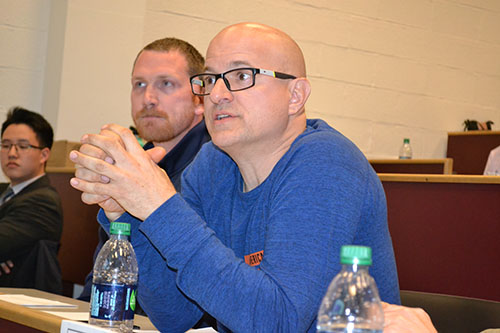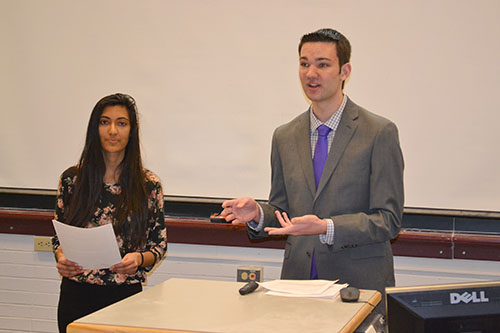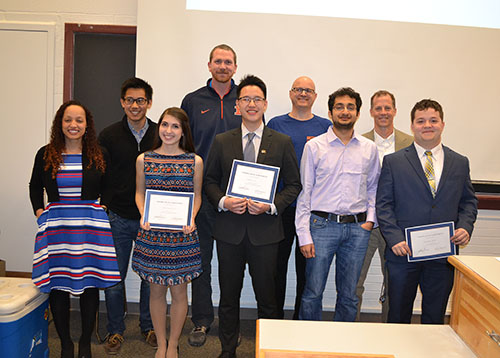Engineering Ambassadors’ Speaking Competition Helps Students Polish Their Communication Skills

Christina Ernst, winner of 1st place in the EA Speaking Competition, speaks about the use of technology during STEM education.
April 11, 2018
Illinois’ Engineering Ambassadors (EA) are serious about being able to speak well in order to communicate to others about engineering. But they also want to help others, including those in other STEM fields, to express themselves well when they communicate. So on Saturday, April 7th, during the Engineering Ambassadors’ Fourth Annual Speaking Competition—SpeakUp!—four finalists, armed with PowerPoints and well prepared by their EA mentors, stood before five judges and spoke for around seven minutes about the "Advancement of Technology in an Engineering Discipline and its Impact and Future Implications in Society." Their goal? To compete and win a prize, of course, but, even more importantly, to improve their public speaking.
Emphasizing one of the tenets of their organization—communicating skillfully about engineering—the EA students ran the competition completely, from making the application, to advertising, to recruiting the students.Those who wished to participate uploaded a video of themselves speaking about an aspect of technology in relation to their discipline. Then, during weekly EA meetings, the Ambassadors, along with EA co-founders and co-faculty advisors, Marie-Christine Brunet, Engineering’s Assistant Dean for Undergraduate Programs, and Bioengineering Associate Professor Jenny Amos, watched the videos of the 10–12 applicants, then voted to determine which students would make the cut and compete as finalists.
Although the competition was open to both undergraduate and graduate students in any STEM major, the four finalists were Engineering students—three undergrads and, for the first time ever, one PhD student. Winners received cash prizes ($150 for first place, $100 for second place, $50 for third).

Above: EA Competition judge Bruce Flaschpart (right) asks one of the finalists a question during the Q&A portion of their presentation.
Below: Another judge, Eddie Sun, a Lincoln Lab technical assistant, discusses the technology addressed by one of the finalists.

A panel of five prestigious judges, Illinois alumni, engineers in industry, and current faculty, evaluated the finalists using a rubric, which the contestants had in advance. The panel was comprised of: Roberta Branco, a manufacturing engineer who works at Caterpillar in Decatur, Illinois; MechSE Professor Bruce Flaschpart, who is also the Director of the Engineering Student Projects Lab; Jack Ingram, an ECE alumnus who is a technical manager working on hybrid automobiles at Delphi; Eddie Sun, a recent Illinois grad who is a technical assistant at Lincoln Laboratory in Massachusetts; and David Tewksbury, a Communication Professor and Associate Dean of LAS.
Also on hand to support and encourage presenters were friends, Engineering Ambassadors, and the finalists’ EA mentors.
While the cash prizes were a nice perk and all four finalists loved the "thrill" of competition, they would most likely admit that it wasn’t just about the money or competing. Like the 40 or so Engineering Ambassadors, they too were serious about being able to better communicate their craft. And while the actual competition was exciting and probably nerve-wracking, it was also educational. It was the process they went through to get to this point that helped them hone their speaking skills.
For example, first, applicants created and uploaded a video of themselves speaking about a technology in their discipline. "So that they can shine,” explains Brunet, finalists were then required to attend a workshop on how to communicate effectively, based on the technical communication class all Ambassadors are required to take. Brunet says the workshop component was added after the first year of the competition, when the quality of the talks was “good…but could have been better.” So they decided, “Maybe we need to use our expertise and train them the same way that we train the Engineering Ambassadors.”

During her talk, Computer Engineering junior, Christina Ernst, exhibits an E-Textile kit, which promotes learning about electronics as the user inserts LEDs and builds circuits into fabric.
For the workshop, finalists prepared material ahead of time on their topic for the competition, then, during the day-long training, learned different techniques and communication skills. They were also assigned an EA student who mentored them both during the workshop and afterwards, as they prepared for the competition.
“So it’s a win-win,” Brunet says of the whole process. “They grow and they learn different skills that are going to be useful not just for their little speech, but also in life. So, how do you communicate clearly, and use jargon, and organize your thoughts?”
Because one of the finalists was a PhD student, did that give him an edge over the undergrads? The two report that Engineering’s curriculum emphasizes writing a lot, but speaking, not as much, so training on how to speak effectively is generally lacking for both undergrad and grad engineering students. “So that’s kind of where we come in,” says Brunet.
“Most students, even PhD students, don’t get formal instruction how to present; you’ve just gotten by in life,” Amos admits.
Regarding the PhD student, Brunet says “He came to the communication workshop, and it was very interesting to see, even for a PhD student, how much they enjoy what they learn.”
According to Amos, the feedback participants receive in EA training is key: “Our whole workshop is about trying, taking risks, and getting feedback,” she acknowledges. “You’re finally getting feedback on your speaking skills and tips on how to make them better. And it’s an iterative cycle, and that’s why it’s effective, even in that short amount of time. They practice; they practice; they get feedback. They practice; they practice; they get feedback.”

Marie-Christine Brunet (left) and Jenny Amos with their gavels.
“They may have been presenting for years,” she adds, “but maybe no one told them…” for instance, about bad or annoying habits they’d acquired. So the training emphasized helping speakers root those out.
To accomplish this, Amos and Brunet have implemented some not-so-subtle, Pavolovian-esque conditioning techniques. Similar to the Gong Show's gong or American Idol's buzzer, one is designed to help participants overcome unfortunate tendencies, such as those ubiquitous, unconsciously-used crutch words—“You Know,” and “Um,” and “Like.” However, rather than a gong or buzzer, Brunet and Amos wielded brightly colored gavels!
 The image of Amos (left) and Brunet frowning their disapproval that's shown to students as a deterrent.
The image of Amos (left) and Brunet frowning their disapproval that's shown to students as a deterrent. Another oft-used technique is “The photo.” This image of Amos and Brunet exhibitting frowns of disapproval is evidently often displayed as a deterrent. Both amelioration techniques were employed not just during the contest, but also crop up during EA events, like the two-minute practice talks during weekly meetings.
So did Amos and Brunet wielding their gavels impact any of the finalists for the better?

Computer Engineering junior, Christina Ernst.
Christina Ernst, a junior in Computer Engineering, when asked about this just prior to the competition, was hopeful. "I'd like to think so," she asserts. "We'll find out in a few minutes. The words always change, so as soon as you bash out the 'ums,' it changes to something else!"
Ernst also believes that she gained confidence via the workshop and mentoring. "I think being able to retain some of that poise is something that the workshop taught me." She adds that she also gleaned some helpful tips: "Things like putting blank slides in your PowerPoints so the audience just focuses on you—that's really helpful. And I think that was a new way of thinking about presentation that I hadn't thought about before."
Had all of the extra practice helped to lessen her fear of being in front of people? "Absolutely," she reports. "And I always think preparation is the best way to keep the nerves away, so that was really helpful to have the EA workshops and some help from the ambassadors too.
Ernst says she signed up to be in the competition because she thinks public speaking is really exciting. "Of course, it's really scary," she acknowledges, "and I do still have that nervousness. It's just very exhilarating to be able to share your ideas with people."
And despite her assertion that public speaking is scary and that she still gets nervous, she evidently did a good job of sharing her ideas with those present—Ernst won first place in the competition.

Darren Liu, a junior in Civil Engineering and winner of second place in the competition.
Darren Liu, a junior in Civil Engineering, who won second place in the competition, reports that he signed up to participate because he loves competing.
“I'm a competitive person,” he reports. “I'm here in U of I engineering, so I figured, ‘Why not?’ It looked like a lot of fun!”
Liu also thought the topic, technology in one's industry, looked intriguing. “That's something I've always been really interested in,” he admits. “I'm in construction management, which doesn't have the reputation of being very technological. But now, it can be. Robotics. In fact, that's what I'm going to be talking about today—using drones for progress monitoring on a job site, and combining those with different computer models.”
Like Ernst, Liu agress that the workshop had improved his speaking.
“That workshop totally changed the way that I look at making a presentation,” he admits. “I used to have that very standard idea of what it should look like. The default PowerPoint theme, the bullet points. Using the assertion evidence method and finding good graphics for each individual image really helped me develop my presentation as a whole. Besides that, organizationally, it really helped me think about the flow of presentations from road map to road map. It's been great.”

Chandler Bott, a junior in Material Science and Engineering
The third finalist, Chandler Bott, a junior in Material Science and Engineering, reports that he signed up for the competition Because he’d had a bit of experience with public speaking in the past, and had never really gotten a chance to continue that in college.
According to Bott, the workshop emphasis that had really helped him was the part about how to make effective slides. “A lot of my experience previously wasn't with presentations that have visuals,” he admits. “It was just pretty much just giving speeches. So having slides behind me was not something that I have a ton of experience with, so they kind of taught me how to effectively make good slides. I think that was the most important part for me.”
The fourh finalist, Kartik Hegde, a PhD student in Computer Science, says he signed up for the competition because as a PhD student, “It's important to be able to present the research effectively,” he acknowledges. “So I think by competing, I get those skills and reduce my stage fear and be able to present better.”

Kartik Hegde shakes hands with EA advisers Amos and Brunet when receiving his certificate.
Like the other finalists, Hegde believes the workshop and training helped him learn, “how to make effective presentations,” and says he also gained “some intricate skills that I didn't know before. I think it helped a lot.”
So while one can see the obvious benefits for the finalists themselves, how does holding a speaking competition every year help the Engineering Ambassadors. Amos and Brunet indicate that it’s beneficial for EA students in a number of ways.

Two Engineering Ambassadors MCing the Competition.
“One of the things that we like to do in Engineering Ambassadors,” says Amos, “is not just impact the community and the university, which is our main mission, but also to develop our own engineering ambassadors and give them the chance to have an impact on others here on campus. I think this is a great way for them to engage with their peers, encourage them to come get trained, and present and showcase some of the skills they gained through the program.”
Amos claims the Ambassadors gain a sense of pride through the competition. “They are able to show their friends what they do and the training that they've been through because they talk about it all the time.”
Plus they’re able to give back—especially to the campus—by “paying it forward and having an impact here on campus that they could see,” she adds, indicating that EA members usually impact mostly K–12 students, so “This is their opportunity to do something for the campus.”

The five judges and the four finalists of the Competition.
Learning how to mentor and reinforcing their own skills by teaching someone else are other positive impacts for the Ambassadors. “You learn a topic better if you're able to teach it,” Brunet acknowledges. “So I think the fact that they're trying to teach and to mentor a skill that they recently acquired is a reminder for themselves and a way of reinforcing the skills as you are practicing them and mentoring somebody.”
Another plus? The competition helps the Ambassadors enhance their leadership skills. “This is something that they get a lot of pride out of doing,” Amos continues, “and we're happy to take our Saturday to help teach this workshop. They organize the whole thing; they pick the participants; they mentor them; they set up the judges. So this is really their thing. It's nice for us to be able to watch them take the lead and organize something.”
They're really improving their leadership skills,” Brunet adds. “Some of them are better than others at delegating, but they're learning on the way. It's very interesting to see.”
Story and photographs by Elizabeth Innes, Communications Specialist, I-STEM Education Initiative.
More: Engineering, 2018
For more I-STEM articles about Engineering Ambassadors:

Left to right: Speaking Competition judges Jack Ingram, Bruce Flaschpart, David Tewksbury, and Roberta Branco.













.jpg)
















